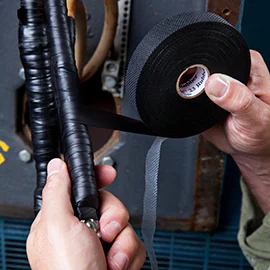The Essential Role of Cotton Tape in Electrical Insulation
In the ever-evolving world of electrical engineering and maintenance, the materials used for insulation and protection are paramount. Among these materials, cotton tape has emerged as a reliable and versatile option for insulating electrical components. This article explores the properties, applications, and benefits of cotton tape in electrical insulation, highlighting why it continues to be a staple in this field.
Properties of Cotton Tape
Cotton tape is made from natural cotton fibers, which are known for their excellent insulating properties. One of the primary advantages of cotton tape is its ability to withstand high temperatures, making it ideal for electrical applications where heat generation is a concern. Typically, cotton tape can endure temperatures of up to 105°C (221°F) without degrading, providing a reliable barrier against electrical currents.
Another crucial property of cotton tape is its breathability. Unlike synthetic materials that can trap moisture, cotton allows air circulation, reducing the risk of condensation and potential shorts in electrical systems. Furthermore, cotton is inherently non-conductive, ensuring that it does not contribute to electrical leakage or interference. This characteristic makes cotton tape highly effective for insulating wires, coils, and other electrical components.
Applications in Electrical Insulation
Cotton tape has a wide range of applications in electrical insulation. It is commonly used to wrap wires and cables, providing a protective layer that prevents exposure to moisture, chemicals, and environmental factors. In addition, cotton tape can be used in transformers, motors, and generators to insulate windings and components, ensuring safe and efficient operation.
In the automotive industry, cotton tape plays a crucial role in insulating electrical systems within vehicles. With the increasing use of complex electronics in modern cars, the demand for reliable insulation solutions has never been higher. Cotton tape’s durability and heat resistance make it an excellent choice for protecting sensitive wiring from heat generated by engines and other components.
cotton tape for electrical insulation

Moreover, cotton tape is frequently employed in the production of electrical appliances, such as power tools and home electronics. It serves as a reliable insulator in high-risk areas where electrical contact could occur. The tape's ability to conform to various shapes and sizes allows for seamless application, ensuring comprehensive protection.
Benefits of Using Cotton Tape
Choosing cotton tape for electrical insulation comes with numerous benefits. Firstly, it is an eco-friendly option made from renewable resources. As industries become more conscious of their environmental impact, the demand for sustainable materials is growing. Cotton tape fits this criterion, offering a biodegradable solution without compromising performance.
Cost-effectiveness is another advantage of cotton tape. Compared to synthetic insulation materials, such as PVC or polyester, cotton tape is often more affordable while still providing excellent insulating properties. This makes it an attractive option for manufacturers and electricians looking to reduce costs without sacrificing quality.
Lastly, cotton tape's versatility makes it suitable for a variety of applications beyond electrical insulation. It can be used for mechanical insulation, as well as in decorative and craft projects, showcasing its adaptability across different industries.
Conclusion
In conclusion, cotton tape serves as an indispensable material in the realm of electrical insulation. Its thermal resistance, breathability, and non-conductive properties make it ideal for protecting electrical components in various applications, from automotive to consumer electronics. As the demand for sustainable and cost-effective materials continues to rise, cotton tape is well-positioned to remain a favored choice among engineers and electricians alike. Embracing the use of cotton tape not only supports reliable electrical insulation but also aligns with the growing emphasis on environmentally friendly practices in manufacturing and engineering.
-
XIANGFAN Rubber Tape-Ultimate Solutions for All Your Insulation NeedsNewsJun.24,2025
-
XIANGFAN Rubber Tape-Protection for Industrial and Residential ApplicationsNewsJun.24,2025
-
XIANGFAN Rubber Tape: Superior Safety and Sealing for Demanding EnvironmentsNewsJun.24,2025
-
XIANGFAN Rubber Tape: Reliable Solutions for Every Electrical ChallengeNewsJun.24,2025
-
XIANGFAN Electrical & Industrial Tape: Powering Reliability Across IndustriesNewsJun.24,2025
-
XIANGFAN Electrical & Industrial Tape: Excellence in Every ApplicationNewsJun.24,2025
